In his book, El 45, Felix Luna remembers the year 1945 (no streetlights, transistor 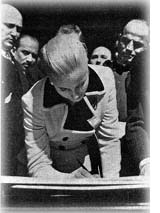 radios, or TV in Buenos Aires but plenty of trolleys, platform shoes and long skirts). In 1945, Luna recalls, Argentina was a country of dusty roads, no air traffic, no tourism, no auto industry. Tucumán was still the “Garden of the Republic” and San Juan was still recovering from the earthquake which brought Perón and Eva Duarte together (Luna, pgs. 52-53). radios, or TV in Buenos Aires but plenty of trolleys, platform shoes and long skirts). In 1945, Luna recalls, Argentina was a country of dusty roads, no air traffic, no tourism, no auto industry. Tucumán was still the “Garden of the Republic” and San Juan was still recovering from the earthquake which brought Perón and Eva Duarte together (Luna, pgs. 52-53).
Evita lived in Buenos Aires in 1945. She knew about Quinquela Martin, the painter from the working class Italian neighborhood of La Boca, and she may have hummed the hit song “J’Attendrai”. But she saw scenes on the streets of Buenos Aires which Felix Luna does not describe: the begging children from the orphanages run by the 87 wealthy old ladies of the Society of Beneficence. The children in the Society’s orphanages, heads shaven, identified by numbers not by names, stood on the street corners holding tin bowls or stiff signs - “Collection for Poor Children.”
Evita knew what it was to be without work and poor, and after she visited postwar Europe in 1947 she learned what to do and what not to do for those who needed help.
First, she listened to Msgr. Roncalli (later Pope John XXIII) when he gave her advice: “Do not burden yourself with official paperwork but preserve the flexibility of a non-bureaucratic organization,” and, because he could measure the caliber of her soul, “devote yourself without limits.” Finally, prophetically, he said, “Remember that the way of service to the poor always ends in the Cross.”
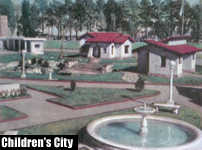 Second, she learned in Europe what to do so that her works would not be spiritually impoverished (spartan, in the language of bureaucrats). Her cities, schools, hospitals, villages for seniors, homes for working women and their children were designed with the concept of helping and respecting people as individuals rather than efficiently accommodating numbers. In the Children’s City, uniforms were banished - but clothes and toys came from the best shops in Buenos Aires. If you look at the children in the residences built by Evita’s Foundation throughout the country you will see that each child is dressed differently (unless they are wearing the smocks all Argentine schoolchildren used to wear to protect their clothes). Second, she learned in Europe what to do so that her works would not be spiritually impoverished (spartan, in the language of bureaucrats). Her cities, schools, hospitals, villages for seniors, homes for working women and their children were designed with the concept of helping and respecting people as individuals rather than efficiently accommodating numbers. In the Children’s City, uniforms were banished - but clothes and toys came from the best shops in Buenos Aires. If you look at the children in the residences built by Evita’s Foundation throughout the country you will see that each child is dressed differently (unless they are wearing the smocks all Argentine schoolchildren used to wear to protect their clothes).
Those of us who have known and loved Evita for many years have to agree with Shakespeare: “The good we do is often interred with our bones.” We have watched the rise of the black legend of Evita, that legend spawned by the Argentine oligarchy, verbalized in one oligarch’s book and set to music by the British who lost their unofficial colony “The Argentine” when Perón won the 1945 elections (two words-Roca-Runciman-will suffice for those who doubt Argentina’s colonial status under the oligarchy). Joseph Page, Robert Crassweller, Marysa Navarro, and Alicia Dujovne Ortiz have published well-researched books disproving the allegations that Evita was a prostitute (“Evita’s image as a prostitute ... had no basis in fact. But it served well the sense of class antipathy and division that was growing up around Perón ... .” Crassweller, pg. 134) consorted with the Nazis ( documents forged after Perón’s fall in 1955 formed the basis for these accusations; see Crassweller, Navarro, and Ortiz) and stole from the rich to give to the poor. “Evita cannot be accused of having kept one peso in her pocket,” stated a member of a commission which investigated the Fundación Eva Perón in 1955. But just as many people’s perception of what really happened in Dallas is formed by Oliver Stone’s JFK, most people’s image of Evita will be formed by the movie.
Part of Evita’s legacy was accomplished in partnership with Perón and Congress. Together they forged a safety net for the children, the workers, the seniors and the poor of Argentina. Each group had a Decalogue of Rights. The Rights of Seniors were to assistance, to a dwelling place, to food, to clothing, to health care, to spiritual care, to entertainment, to work, to tranquility and to respect. The workers’ safety net included access to health care, minimum wage, paid vacations, pensions. Also, Evita was instrumental in obtaining the vote for women. In 1951, women were elected to Congress for the first time. And they were all Peronistas. Only the Partido Peronista Feminino had presented a list of women candidates for Congress.
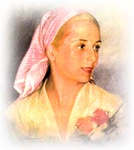 The cornerstone of Evita’s legacy of social justice was the Fundación Eva Perón. Evita, following Msgr. Roncalli’s advice, did not become involved in the book keeping aspects of running the Fundación. She left that to Ramon Cereijo, Minister of Finance, who “received and countersigned thousands of cheques that came to the Foundation... as required by law” (Navarro, 120). Funds for the Foundation came mostly from the workers; “these donations, which formed the bulk of the Foundation’s assets, seem to have been made freely and without complaint” (Navarro, 120). The unions offered the first fifteen days of their pay raises to the FEP, and in 1950 the CGT volunteered two working days of salary to the FEP. Other funds came from labor contracts, lotteries, casinos, a movie ticket tax, a racing tax, Congress, and small businesses. People who sing along with the lyrics, “and the money came rolling in,” will smile smugly but researchers have this to say: The cornerstone of Evita’s legacy of social justice was the Fundación Eva Perón. Evita, following Msgr. Roncalli’s advice, did not become involved in the book keeping aspects of running the Fundación. She left that to Ramon Cereijo, Minister of Finance, who “received and countersigned thousands of cheques that came to the Foundation... as required by law” (Navarro, 120). Funds for the Foundation came mostly from the workers; “these donations, which formed the bulk of the Foundation’s assets, seem to have been made freely and without complaint” (Navarro, 120). The unions offered the first fifteen days of their pay raises to the FEP, and in 1950 the CGT volunteered two working days of salary to the FEP. Other funds came from labor contracts, lotteries, casinos, a movie ticket tax, a racing tax, Congress, and small businesses. People who sing along with the lyrics, “and the money came rolling in,” will smile smugly but researchers have this to say:
“... although the Foundation adopted ‘luxury’ as a matter of policy, it did function better than many more rational and more frugal institutions. For the first time, there was no inequality in Argentine health care.
"Allegations of waste are difficult
to substantiate if a high proportion of whatever the money is spent on
is actually delivered. Evita's hospitals were expensive but they worked
and they lasted; so would most of her other works had they been permitted
to.
...Many of the things she made available-pots
and pans, beds, houses, sewing machines, footballs-had meaning and usefulness
because Evita was aware exactly what difference it made to the life of
a poor family to have these things. The work of the Foundation was deeply
practical and personal, far more so than it might have been had it been
bureaucratically exercised." (Navarro, 131).
"...the Foundation continued...until
the demise of the regime. It was often accused of being a personalist
organism; nevertheless after Evita's death, it continued its activity.
It was accused of waste and disorder, yet almost half a century later,
it would be acknowledged that Argentina had never had a more organized
institution. The Foundation functioned as it pleased, unaffected by bureaucracy-but
it worked." (Ortiz, 286)
"A very Catholic lady, Adela
Caprile, a member of the liquidating commission of the Foundation that
was established Peron's fall in 1955, said, "Evita cannot be accused
of having kept one peso in her pocket. I would like to be able to say
as much of all the ones who collaborated with me in the dissolution of
the organization.'" (Ortiz, 236) Caprile was adamant: the Foundation
was not a fraud.
As Argentine historian Felipe Pigna pointed out (Página 12, 30/4/2007), “All the magnifying glasses were trained on investigating the funds of the Fundación Eva Perón, but in 1946 only 5% of the funds of the Ladies of Charity went to their works, while the remaining 95% went to pay the salaries of these ladies.”
Evita’s Foundation constructed twelve hospitals throughout the country. The 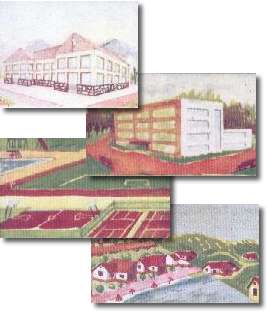 Polyclinic President Perón in the working class neighborhood of Avellaneda was a teaching hospital. It sent out a Tren Sanitario in 1951. The train went throughout Argentina providing free inoculations, x-rays, medicines. All the Foundation hospitals paid high salaries and were able to attract the best doctors. Their wards were small - three patients to a ward. Medical supplies and medicine were supplied by the Foundation and free to the patients. Polyclinic President Perón in the working class neighborhood of Avellaneda was a teaching hospital. It sent out a Tren Sanitario in 1951. The train went throughout Argentina providing free inoculations, x-rays, medicines. All the Foundation hospitals paid high salaries and were able to attract the best doctors. Their wards were small - three patients to a ward. Medical supplies and medicine were supplied by the Foundation and free to the patients.
Evita established a School of Nursing. Just as she worked to get women the vote and a place in Congress so she worked with the head of the School of Nursing, Teresa Adelina Fiora, to create a new kind of nurse - one who could drive a jeep, set up and run a clinic in the interior of the country where doctors were scarce, go overseas on humanitarian missions, take initiative.
Evita was concerned with providing her special loves - the children, the seniors, the workers and the poor - with housing that was more than adequate (“adequate” was not acceptable to Evita). Her “Ciudad Evita” was ahead of its time - each family had its own dwelling place. The shops, the church, the stadium were within walking distance, preserving a sense of community. The idea of single family dwellings for low income families is still considered novel in the US, but Evita’s cities were built in the early ‘50’s.
Her Homes for Seniors were really “ villages,” complete with workshops so that those who wanted to continue working at a useful occupation (from carpentry to milking cows) could do so. Evita believed that seniors should live in a place that encouraged them to go on living, not just wait for death.
Her Children’s Homes, the Hogar-Escuelas or Home-Schools, were also a place to live securely and to grow, a place where you were called by your name, never by a number, and never a place where you would have your head shaved as punishment because you were poor.
The annual Children’s and Youth Championships not only encouraged young people, even the most underprivileged in poor rural areas, to practice sports and compete on a national level; all participants were required to undergo complete physicals and dental checkups. Those who needed medical attention or counseling were sent to hospitals and their cases followed up by Fundación social workers. Doctor Ramón Carillo, Minister of Health, who had created “Sports Medicine,” supervised the medical attention given to the children, the “only privileged in the New Argentina.” By 1955, the championships included eleven sports (chess, basketball, soccer, gymnastics, swimming, jumping, water polo, fencing, racquetball, athletics, throwing). The young people were given uniforms and equipment free of charge and participated with enthusiasm. In this way the championships brought medical care to thousands of children, many from poor rural areas with no access to health care.
Evita established Hogares de Tránsito, temporary dwelling places for women and their children until work and housing could be found; la Hogar de la Empleada, a home for working women; Unidades Básicas, Basic Units where women could go to learn a skill or obtain emergency help; the Foundation built 1,000 schools... all in seven years!
Evita also worked to reform the penal system, especially for women. She arranged for childcare within the system so that children could remain with their mothers and for classes (in sewing or providing services such as those offered in a beauty salon) so that when they left the prison, the women would have the skills necessary to support themselves. She made sure that prisoners were offered recreational activities-sports, 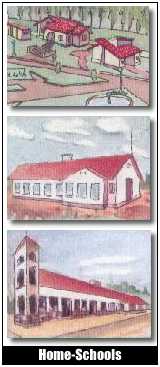 movies-and were paid for the work they did. movies-and were paid for the work they did.
She wanted prisoners to be treated with dignity and not humiliated.
In her book My Sister Evita, Erminda Duarte relates how Evita provided a suit for one woman so that she could wear street clothes when she went to the hospital to visit her seriously ill mother- accompanied by one guard, also wearing street clothes.
Evita had premonitions. She knew who her enemies were and she knew - to a certain extent - what they were capable of. Once she looked sadly at the sign over one of her hospitals and said, “I leave them the easiest task - taking down the signs.” Did Evita imagine that after Perón was overthrown in 1955, her enemies would not be content to take down the signs? Instead, they would destroy the buildings. When I studied social work in Argentina, I heard the story of Evita’s Children’s Hospital. It was to be the best in Latin America, and it was almost ready for inauguration in 1955. Only a few minor details, such as installing faucets, had to be completed. When the military took over, they abandoned it and it became the Albergue Warnes (Warnes was the street it was on), a refuge for outcasts and thieves, until it was finally destroyed. And all the military would have had to have done was install faucets!
If you want to know what happened when the military took over in 1955, try to imagine this: everything built by any charitable foundation, every hospital, school, homeless shelter, every program designed to help people who have fallen through the safety net while Reagan and Bush were Presidents would be destroyed, dismantled, razed or looted by the Clinton administration - because, after all, Reagan and Bush were Republicans and Clinton is a Democrat. Sound absurd and totally stupid? That is what happened in Argentina. Thousands of bottles of blood were smashed in blood banks all over the country because the seals on the bottles said “Fundación Eva Perón.” Thousands of sheets were burned because it was too much work to cut out the offensive words “Fundación Eva Perón.” Children died in polio epidemics because the iron lungs, imported from the United States, were locked away or destroyed. How could they be used when each one had a small metal plate which said “Fundación Eva 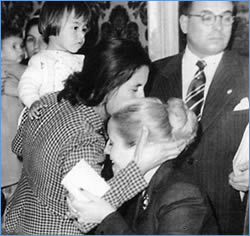 Perón” ? Military officials sent trucks to remove draperies and furniture from Evita’s establishments. They were too good for the working classes but good enough for the military. The officers turned Evita’s Hospital for Sick Children in Termas de Reyes in the poor northern province of Jujuy into a resort for themselves and their families. Instead of destroying the Children’s City in the Buenos Aires suburb of Belgrano, they turned it into a rehabilitation center for people stricken with polio- of which there were many. A navy officer told me that himself. He hated Evita and wanted to wipe her works off the face of the earth. But his daughter had polio so for him it made more sense to use this one establishment than to destroy it. No one cared about the miniature children’s village, though, and the little buildings were going to ruin. Peronistas were second-class citizens after 1955, forbidden to present candidates for election until the ‘70’s. Finally the day came when the ruling class had to permit Perón to return, not , as he himself explained, that he had been so good but because those who came after him had been so bad. He returned, he said, to die in the service of his country. He did die in office and his third wife, Isabel, became President. When inflation hit 2000% the military came back into power. This time they did not need to destroy Evita’s works. They’d done that job earlier. Instead they destroyed 30,000 of their country’s citizens in the Dirty War. Perón” ? Military officials sent trucks to remove draperies and furniture from Evita’s establishments. They were too good for the working classes but good enough for the military. The officers turned Evita’s Hospital for Sick Children in Termas de Reyes in the poor northern province of Jujuy into a resort for themselves and their families. Instead of destroying the Children’s City in the Buenos Aires suburb of Belgrano, they turned it into a rehabilitation center for people stricken with polio- of which there were many. A navy officer told me that himself. He hated Evita and wanted to wipe her works off the face of the earth. But his daughter had polio so for him it made more sense to use this one establishment than to destroy it. No one cared about the miniature children’s village, though, and the little buildings were going to ruin. Peronistas were second-class citizens after 1955, forbidden to present candidates for election until the ‘70’s. Finally the day came when the ruling class had to permit Perón to return, not , as he himself explained, that he had been so good but because those who came after him had been so bad. He returned, he said, to die in the service of his country. He did die in office and his third wife, Isabel, became President. When inflation hit 2000% the military came back into power. This time they did not need to destroy Evita’s works. They’d done that job earlier. Instead they destroyed 30,000 of their country’s citizens in the Dirty War.
Who was Eva Perón? That’s easy. The wife of the President of Argentina.
Who was Evita? Saint Evita? Her confessor, Father Benitez, said she loved her clothes and jewels too much to be a saint (although when she was ill, she said “If I get well and can return to help the poor all I’ll need is a skirt and blouse”). Evita revolucionaria? After a failed revolt by the military in 1951, she bought weapons from Prince Bernard of the Netherlands to arm the CGT. She was certainly a revolutionary.
What is Evita’s greatest legacy?
Hospitals, homes, and schools do not last forever. Legislation which gives the vote to women or bans the use of land mines is only effective if it can be enforced. Mother Teresa said to “give until it hurts.” Princess Diana wanted us to look at the poor and rejected with a new heart and showed us the way. Evita often told her followers, “I leave you my heart.” It is not enough to admire these three great women of the twentieth century. If we want their legacy to live on into the twenty-first century, we must consider ourselves their beneficiaries. We must inherit their hearts and imitate their actions.
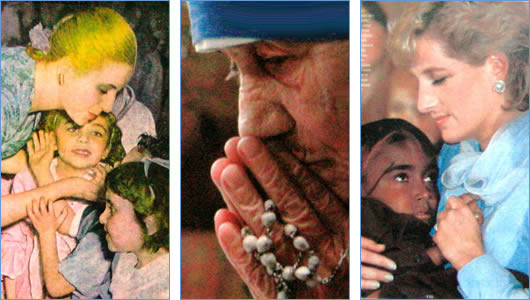
Bibliography
Crassweller,
Robert D. Perón and the Enigmas of Argentina. New York: W.W. Norton
& Company, 1987.
Fraser, Nicholas & Marysa Navarro. Evita: The Real Life of Eva Perón.
New York: W.W. Norton & Company, 1996.
Luna, Felix. El 45. Buenos Aires: Editoral Sudamericana, 1975.
Ortiz, Alicia Dujovne. Eva Perón. New York: St. Martin's Press,
1996.
Page, Joseph. Perón: A Biography. New York: Random House, 1983.
Fundación
Eva Perón. Eva Perón and Her Social Work. Buenos Aires: Subsecretaria
de Informaciones, 1950.
Escuela
de Enfermeras. Buenos Aires: Subsecretaria de Informaciones, 1951.
Copyright January 10, 1997. All rights reserved.
|
